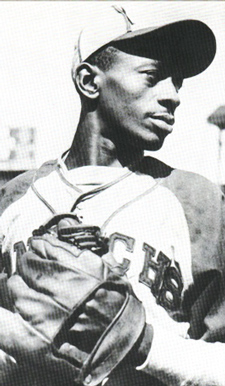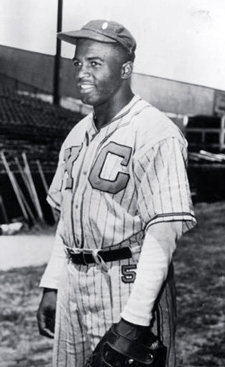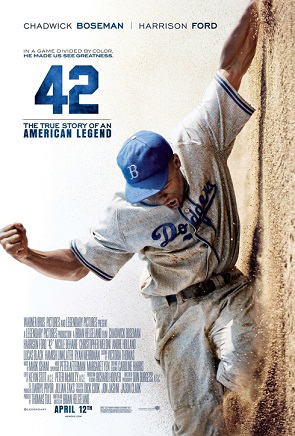White Supremacy, symbolism and Blacks in Major League Baseball
By Askia Muhammad -Senior Editor- | Last updated: Apr 23, 2013 - 6:30:06 PMWhat's your opinion on this article?

The two opposing teams line up at the 1924 Colored World Series. Photos: Library of Congress
|
WASHINGTON (Finalcall.com) - On the eve of the world premiere of a feature film about baseball’s immortal Jackie Robinson, and 66 years after Mr. Robinson became the first Black player in the big leagues, Major League Baseball (MLB) formed a committee to study why fewer Blacks are playing the game today.
The 2012 World Series champion San Francisco Giants are one of several MLB teams which had no Blacks on their 25-man rosters on opening day this season, and the percentage of Black players overall is down to 8.5 percent today, compared to an all-time high of 19 percent in 1986. That number would be even smaller, if Black players from Central American countries were excluded from the census.

Satchel Paige
|
“I don’t want to miss any opportunity here,” MLB commissioner Bud Selig told baseball writer Mike Axisa of CBS Sports.com in an interview. “We want to find out if we’re not doing well, why not, and what we need to do better. We’ll meet as many times as we need to, to come to meaningful decisions.”
And while the motive for wanting Black players in the sport appears to be well meaning, it may very well be as rooted in racism-White supremacy as it is in the love of the game. Mr. Robinson was one of many superior Black players who played in baseball’s Negro Leagues, when baseball, like most of American life, was segregated.
“Racism-White Supremacy, with the specific definition of racism-White supremacy in parenthesis, is the dominant power context,” psychiatrist Dr. Frances Cress Welsing told The Final Call.
“This is what I feel that Whites consciously and subconsciously think that if the Negro Leagues had just been allowed to go on and flourish, and you had White leagues going on and flourishing, you would then see the Blacks dominating all the time. So, then they cut out the Negro Leagues and then they select(ed) a few Blacks to play, (so today) you are not looking at Blacks constantly beating Whites.

Jackie Robinson in uniform for the Kansas City Monarchs.
|
“What would you imagine would be the result if the so-called Negro Leagues had been allowed to continue? Who would you imagine would dominate?”
In fact there was a time when a baseball team, dominated by Black players and led by pitcher Leroy “Satchel” Paige, catcher Quincy Troupe and five other Blacks were champions in a White league. It was the Bismarck, N.D. town team, and they won handily in 1933 and 1935 (Mr. Paige did not play in 1934), even though the population of the state’s capital was only 46 out of the 377 Negroes living in the state at that time.
But the major leagues reflected the prevailing American attitude that Black people were “inferior” to Whites and did not deserve equal accommodations with Whites anywhere or at any time.
The new film is called “42” and it features Chadwick Boseman in the lead role, and Harrison Ford as Brooklyn Dodgers manager Branch Rickey who made the critical decision then went on a two-year recruitment campaign to find an ideal Black player who would not only help his team win games, but one who had the character and endurance to withstand the racial backlash from not only opposing players and fans, but from his teammates as well. Mr. Robinson was that player, and he excelled beyond expectations, winning the rookie of the year in 1947, performing feats like stealing home base, that are still the stuff of legends today, and by winning friends with his endurance of the abuse.
There are a number of curious ironies however, surrounding the new film. The title of the film is “42” taken from his jersey number, which has been retired throughout the major leagues. Only one of the 30 MLB teams still has a player who wears number 42, and when New York Yankees pitcher Mariano Rivera retires, the number will be permanently retired throughout the league.
On March 18, 1942 Nate Moreland, a fellow baseball player and Mr. Robinson’s neighbor in his hometown Pasadena, Calif. asked Chicago White Sox manager Jimmy Dykes for a tryout for the two men. Mr. Dykes permitted the two to workout with his team. Of course neither player won a spot on the White Sox roster.
But 1942 was also a year in which there was a major challenge in the Black community to the foundations of Jim Crow baseball, tied to the hypocrisy of Blacks fighting for this country in the heat of World War II, but unable to participate in the national pastime. “I can play in Mexico,” Mr. Moreland who became a pitcher for the team El Centro Mexicali protested, “but I have to fight for America where I can’t play.”
A continent away, on May 8, 1942 the Most Honorable Elijah Muhammad was arrested in Washington, D.C., after President Franklin Roosevelt issued an executive order to have Mr. Muhammad taken off the streets because of his opposition to Black participation in the U.S. armed forces. Mr. Muhammad was charged with refusing to register for the draft, even though at age 44 Mr. Muhammad was already two years beyond the age for Selective Service registration.

Theatrical release poster for the film 42.
|
For his part, Mr. Robinson served briefly as a second lieutenant in the United States Army. He never saw combat, however. He was arrested and court-martialed during boot camp after he refused to move to the back of a segregated bus during training. He was acquitted and given an honorable discharge.
Ironically, at the time of Mr. Robinson’s breakthrough a committee was formed—not unlike the committee formed at this hour—to help baseball overcome its “Negro problem” then. The late Queen Mother Audley Moore of Harlem, then 84 years old told this writer for a 1982 documentary, for The Black Scholars Radio series, that in her early years, she had tried to be a “good Negro” and that she was involved in just such an effort.
“I worked hard at it. And this was what I did as a Negro,” she said. “I’ll give you an example of it. A group of people, my enemies, asked me to form a committee to get Black players into the Major League Baseball. I formed a committee, and had Adam Powell and Captain Hugh Mulzac to head it.
“This act broke up the Black teams, killed Black business in southern towns and cities, and many old ladies who sold pies, and there were hot dog stands, popcorn, shoeshine boys, Black restaurants, Black hotels. This business was all lost through my act, acting through my Negro mind.
“Had I not been a Negro, I would have told that group of my enemies that I would get the Black teams into baseball, not the Black player. Now, do you see the qualitative difference between getting the player in, and getting the Black teams in?”
The new 2013 committee will be chaired by Detroit Tigers general manager Dave Dombrowski. Former New York Mets manager Jerry Manuel, Stanford University athletic director Bernard Muir and senior director of the MLB scouting bureau Frank Marcos will also serve on the committee, in addition to several other front office employees from around the league.
For her part, Dr. Welsing authored a famous “balls theory” which says that in sports which are played with large brown balls, like football and basketball, Black players are dominant. In sports played with small white balls, like golf, tennis and baseball, Blacks are not so dominant.
This she explains is tied to the subconscious White fear of “genetic annihilation” caused by the reality that genes that control for dark skin and brown eyes are dominant over genes that control white skin and blue eyes, which means that Caucasian (White) people—who are already a minority of the world’s population—would cease to be White if they intermarried with darker-skinned people.
“Those facts are essential to understand, because the part of the anatomy where the genetic material is stored in men is the testicles, and testicles are referred to colloquially in this culture as ‘balls.’ As a result of that, we have evolving at conscious and subconscious levels an obsessive focusing on ball games,” said Dr. Welsing.
“The ball games, the balls are really referring symbolically to the testicles. Black men have testicles which have dominant genetic material. And so the games are reflective—irrespective of who is playing them—are big brown balls and small white balls. The small size of the balls is a symbolic statement about the genetic recessive character of White genetic material, compared to the genetic dominant character of Black genetic material.
“Even though people are looking at it, day-in, day-out, unless they have the contextual power frame of a system of racism White-supremacy that is about White genetic survival, they won’t even see it. They’re looking at it, but they don’t see, because seeing is really context driven.
“So that if you have the concept that we are in a system of democracy, you won’t see it. But, if you understand we are in—the reality is, not what is wished for—the reality is that we are in a local-national-global system of racism-White supremacy, and White supremacy is driven by the fear of White genetic annihilation.”
“So much of this is played out symbolically. Even when there were no Black players, White men were reflecting what they knew their women desired,” said Dr. Welsing. “This is not what people consciously reflect on. Symbolism comes from the subconscious, and very often it comes when there is a lot of material in the subconscious that is being denied.
“If you want to understand anything that is happening, including gun control, there cannot be gun control because the gun is the symbolic response to White people being genetically annihilated by Black people, and by Black men. So (the White man) has to have the gun as the ‘Great Equalizer,’ (to) the genitals.”
“The one thing that cannot be talked about in the system and culture of racism, White supremacy, is racism-White supremacy,” Dr. Welsing concluded. “This is a topic we’re not going to discuss.”
And so it is rarely discussed, even in the conversation about there being so few Black players in Major League Baseball today.
INSIDE STORIES AND REVIEWS
-
-
About Harriett ... and the Negro Hollywood Road Show
By Rabiah Muhammad, Guest Columnist » Full Story -
Skepticism greets Jay-Z, NFL talk of inspiring change
By Bryan 18X Crawford and Richard B. Muhammad The Final Call Newspaper @TheFinalCall » Full Story -
The painful problem of Black girls and suicide
By Charlene Muhammad -National Correspondent- » Full Story -
Exploitation of Innocence - Report: Perceptions, policies hurting Black girls
By Charlene Muhammad -National Correspondent- » Full Story -
Big Ballin: Big ideas fuel a father’s Big Baller Brand and brash business sense
By Bryan Crawford -Contributing Writer- » Full Story






 Click Here Stay Connected!
Click Here Stay Connected!








